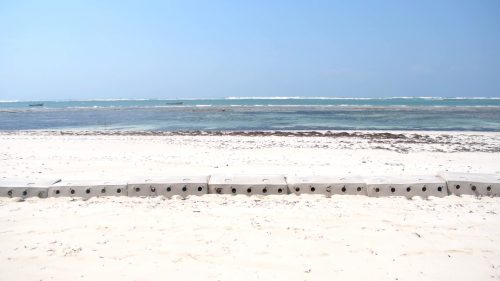Sandsaver, a rotationally molded beach erosion barrier re-nourishes sand at 5 star African resort beach on the Indian Ocean.

Middletown, United States of America - December 17, 2020 /MarketersMedia/ —
Beach erosion plagues communities all across the World for billions of dollars per year in maintenance, property loss and re-nourishment. Many experts claim that rising water levels and global warming are additional contributors to the beach erosion issues caused by the removal of sand from a beach to deeper water offshore or along inlets, tidal shoals and bays. While 2020 was the year of the Covid-19 pandemic, it was also a year in which multiple coastal communities across the globe saw homes fall into bodies of water due to beach erosion. 2020 started off the year with a Montague, Michigan home falling into Lake Michigan of the Great Lakes in January of 2020. A home in Harbor Island, South Carolina became a victim to circumstances of coastal erosion as it plunged into the Ocean before the month of January was up. North Carolina experienced its own incident of a home falling into the Atlantic Ocean when an Outer Banks home crumbled into the Atlantic Ocean surf, littering debris along the beach for as much as a half of a mile. In July, luxury homes in New South Wales, along the coast of Australia were overcome by encroaching water levels, swallowing backyards and porches, while collapsing balconies.
While summer and vacation travel was greatly reduced because of the Covid-19 pandemic, beaches were still a highly sought out destination location during the virus outbreak. News crews showed footage of crowded beaches during Spring Break and throughout the summer in various parts of the World. However, reduced beach attendance didn’t reverse the course of the eroding beaches.
An opulent 5 star resort located in Kenya has been battling beach erosion issues for years. Situated on the beautiful Indian Ocean, the resort had previously tried a number of technologies in effort to stop the beach erosion and attempt to re-nourish the previously award winning beach with no success whatsoever. After previous unsuccessful attempts, the ownership of the resort elected to install the Sandsaver, a rotationally molded, natural solution to beach erosion.
Previously proven in the United States in Lake Michigan, the Sandsaver offers the ability to break down the wave energy as the waves crash against the concrete filled rotationally molded beach erosion barriers. The modules feature tapered thru holes, that have a larger opening on the front or surf side of the module, that tapers down to a smaller hole on the beach side of the module. The tapered holes allow for the sand to travel from the surf side of the module to the beach side of the module, allowing for the sand to pass thru and settle on the beach side of the modules while the surf retreats back to the body water, finding the least path of resistance. The tides continue to come and go, carrying sand in the water column, necessary for the accretion of sand on both the beach and surf side of the modules. This continuous tide activity will lead to sand being accreted on both sides of the module and increasing the overall width profile of the beach. As this cyclical surf activity continues, the Sandsaver modules eventually become completely submerged in sand.
Sandsaver continues to show promise of protecting and re-nourishing the Indian Ocean Beach at the resort in Africa. Since it’s early 2020 installation, extremely conservative estimates show that the Sandsaver system has already accumulated over 30,000 cubic yards of sand, while increasing the width profile of the beach over 200 feet in some areas of the installation, in as little as 6 months. The Sandsaver barriers ability to protect and re-nourish the beachfront property has even caught the attention of various entities of the African government, in hopes of possibly offering the solution along the beautiful and majestic coasts of Africa.
The Sandsaver has now protected and re-nourished (3) beaches on (2) continents. Sandsaver’s initial test came on Lake Michigan of the Great Lakes, where the system proved its ability to stand up to substantial surf activity and accrete sand on both sides of the module. Since the Lake Michigan installation, Sandsaver has since been installed in the Gulf of Mexico and the Indian Ocean, where both installations are showing positive signs of sand accumulation and beach protection. The success of these 3 installations proving Sandsaver as a beach erosion solution continues to garner attention all around the World as families, companies and governmental agencies look for a beach erosion solution.
The Sandsaver is a rotationally molded innovation from internationally recognized rotomolding leader, Granger Plastics Company. Granger Plastics Company, specializing in complex, rotationally molded products has been in business for over 26 years. Granger Plastics Company is a division of Granger Industries Inc., which includes ForeverSafe Products, the Granger ISS Tornado Shelter, the Sandsaver beach erosion barrier and Granger’s custom rotational molding entity, Granger Plastics Company. Granger welcomes inquiries from areas suffering from beach erosion or paying for renourishment methods that just are not working. The Sandsaver offers the ability to work in areas where previously tried erosion control methods have failed or only provided temporary solutions. To learn more about the Sandsaver, please visit www.sandsaver.com or www.beacherosionsolution.com for more information and details.
Contact Info:
Name: Shawn M Cravens
Email: Send Email
Organization: Granger Plastics Company
Address: 1600 MADE Industrial Dr
Phone: 15134241955
Website: https://www.grangerplastics.com
Video URL: https://www.youtube.com/watch?v=jFbiy1HA0ag
Source URL: https://marketersmedia.com/coastal-erosion-barrier-re-nourishes-indian-ocean-beach/88990060
Source: MarketersMedia
Release ID: 88990060